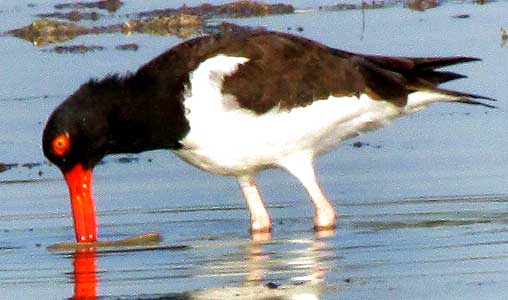Excerpts from Jim Conrad's
Naturalist Newsletter
from the January 18, 2015 Newsletter issued from Río Lagartos, on the Yucatan Peninsula's northern coast (~N21.60°, ~W88.16°), Yucatán state, MÉXICO
OYSTERCATCHER
Sometimes the mudflats are covered with hundreds or even thousands of sandpipers, plovers, skimmers, gulls, terns and the like, but you'll be lucky if there's a single American Oystercatcher, HAEMATOPUS PALLIATUS, among them. But, if there is one, it'll be easy to see, and below you can see why:

The bird's big, heavy beak is used not only to stab into submerged mud looking for food, but also to pry open oysters, clams, mussels and other bivalve mollusks. It also eats sea urchins, starfish, crabs, worms and other marine invertebrates.
The Oystercatcher has a special way of dealing with the hard shells of bivalve mollusks like oysters, clams and mussels. It looks for feeding individuals with their shells cracked open. The bird jabs its bill into the open shell and tries to sever the strong muscle that clamps the shells shut. This technique works well enough, but sometimes there's a problem, especially when the mollusk is a big one firmly rooted in its substrate. Then the bivalve may clamp its shell on the bill and hold the bird in place until the tide comes in, drowning it. Oystercatchers also feed by carrying loose shellfish out of the water and hammering at their shells. Another approach is to probe for buried soft-shell or razor clams whose shells are softer.
Visitors always ask if the Oystercatchers eyes really are as large as they seem. Most of the apparent size consists of a red ring around the orange eye. In our picture you can barely see the orange eye centered in the large, red eye ring.
American Oystercatchers are found along American coasts from southern California to central Chile on the Pacific side, and from New England to Brazil on the Atlantic side. In the 19th century they became locally extinct in the US Northeast due to hunting and egg collecting. After receiving protection under the Migratory Bird Treaty Act, their range extended northward to reoccupy areas they'd disappeared from.